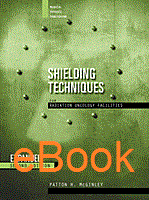
Shielding Techniques for Radiation Oncology Facilities, Second Edition
Author: Patton H. McGinleyISBN: 9781930524675
Published: 2002 | 184 pp | eBook
OUT OF PRINT
Radiation Protection Dosimetry (Review of the First Edition) | Vol. 83, No. 3 (1999)
Review of the First Edition:
"The stated objective of this book is to provide an update of shielding methods for radiation producing devices of modern radiation oncology. There have been many changes in the radiation sources and irradiation techniques for oncology since the present techniques for shielding were introduced. The updating is very welcome because the designers of barriers meet frequently special problems which are not considered in the current shielding codes of practice. "The book has been developed from a course in radiation shielding. It includes a review of the recommendations given by the NCRP for shielding design, versatile descriptions of shielding methods and illustrations of the parameters that specify the starting points for calculations. Comparisons are further made between calculations based on the NCRP reports and recent studies on shielding design. Examples of calculations and homework problems are also given. The descriptions of the methods and the worked examples complete each other, guiding designers of the protective barriers in solving unusual and complicated problems. "The first six chapters of the book concern the history of X-ray room shielding methods from the time of discovery of radiation to the modern radiation therapy period, calculation methods of conventional shields and maze design, photoneutron production and its associated shielding problems, and optimum use of concrete and metals as barrier materials. Chapter 7 discusses special topics like radiation skyshine and shielding of ceiling, lead-through of high voltage cables, ozone production caused by radiation interactions with oxygen, air activation through the photoneutron 14N and 16O reactions and photon and neutron dose equivalent rates in the vicinity of an 18 MeV accelerator room. The next chapter describes the shielding techniques for simulator, high dose rate afterloading and brachytherapy rooms, and the last chapter gives advice and checklists for reporting and inspection of radiation shielding. "The text is very explicit and drawings illustrative. The book is thus enjoyable to read. It gives both a general view and solutions for the problems in designing barriers for modern radiotherapy rooms. A flaw in the contents is that no review has been given on the use of Monte Carlo simulation for calculation of optimum barriers. Because of its versatility, the book is suitable for senior and graduate level courses of health physics. It can also be used as a methodical guide to special shielding techniques, both for experienced designers and those who face for the first time the task of designing or inspecting shielding of oncology rooms." M Toivonen STUK, Helsinki FIN-00881 Finland

